Mark Caney's Blog, page 8
February 12, 2017
200 whales stranded in New Zealand
More than 200 whales stranded on a remote beach in New Zealand on Saturday have refloated themselves and returned to sea.
But conservation officials have warned that they could still turn back to the beach at Farewell Spit, South Island.
Earlier, volunteers managed to refloat some 100 of the more than 400 pilot whales which beached on Thursday.
However a human chain, with volunteers wading neck-deep into the water, failed to prevent a fresh pod making landfall.
“The 240-odd whales that had stranded between Puponga and Pakawau late on Saturday have mostly refloated themselves on last night’s high tide and are milling around in shallow water,” conservation spokesman Herb Christophers said.
Seventeen of the group which remained stranded were refloated by rescuers and volunteers who were working on the spit.
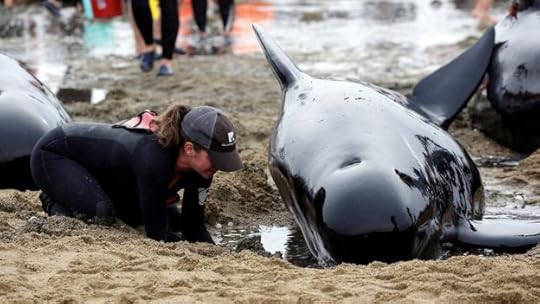
The environmental group Project Jonah, which is assisting with the rescue, has a plane flying over the bay to keep track of the whales’ movements.
The whale stranding is one of the worst ever in New Zealand. Dozens of volunteers have turned out to help since the incident was first reported on Thursday.
More than 300 of the 400 original arrivals died while medics and members of the public tried to keep survivors alive by cooling them with water.
Full story: BBC

More than 200 whales stranded on a remote beach in New Z...
More than 200 whales stranded on a remote beach in New Zealand on Saturday have refloated themselves and returned to sea.
But conservation officials have warned that they could still turn back to the beach at Farewell Spit, South Island.
Earlier, volunteers managed to refloat some 100 of the more than 400 pilot whales which beached on Thursday.
However a human chain, with volunteers wading neck-deep into the water, failed to prevent a fresh pod making landfall.
“The 240-odd whales that had stranded between Puponga and Pakawau late on Saturday have mostly refloated themselves on last night’s high tide and are milling around in shallow water,” conservation spokesman Herb Christophers said.
Seventeen of the group which remained stranded were refloated by rescuers and volunteers who were working on the spit.

The environmental group Project Jonah, which is assisting with the rescue, has a plane flying over the bay to keep track of the whales’ movements.
The whale stranding is one of the worst ever in New Zealand. Dozens of volunteers have turned out to help since the incident was first reported on Thursday.
More than 300 of the 400 original arrivals died while medics and members of the public tried to keep survivors alive by cooling them with water.
Full story: BBC

February 11, 2017
Race to save 100 stranded whales on New Zealand beach
Hundreds of locals and conservation officers have been trying to rescue the survivors since early Friday and formed a human chain to refloat the whales.
Scientists do not know what exactly causes whales to beach themselves.
But it sometimes happens because the whales are old and sick, injured, or make navigational errors particularly along gentle sloping beaches.
Sometimes when one whale is beached, it will send out a distress signal attracting other members of its pod, who then also get stranded by a receding tide.
Are whales attempting suicide when they strand themselves?
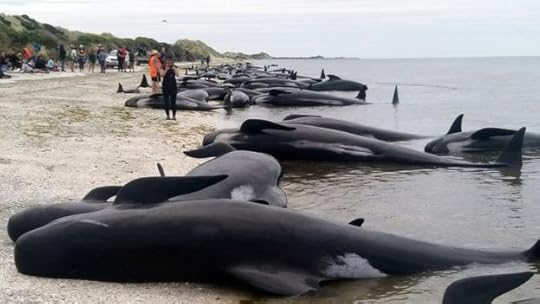
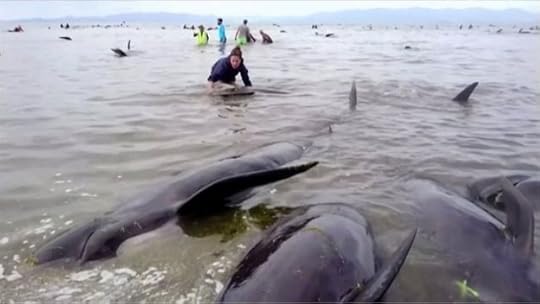 The conservation department said it had received a report about a possible stranding on Thursday night, but did not launch the rescue operation until Friday morning as it was too dangerous to attempt a rescue in the dark, reported the New Zealand Herald.
The conservation department said it had received a report about a possible stranding on Thursday night, but did not launch the rescue operation until Friday morning as it was too dangerous to attempt a rescue in the dark, reported the New Zealand Herald.Source: BBC

January 19, 2017
Dolphins are mysteriously washing up on Cornish beaches in greater numbers
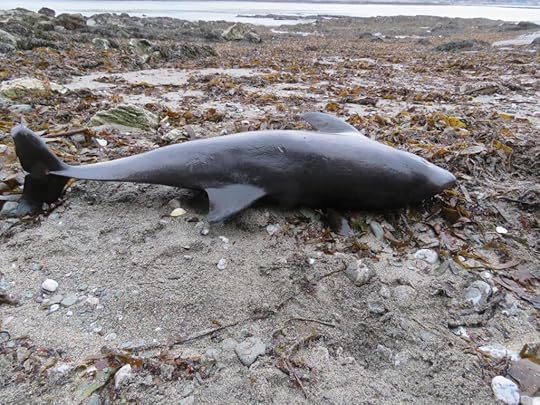 Marine experts are investigating after the number of dolphins being washed up on the UK’s Cornish coast increased six-fold in a year.
Marine experts are investigating after the number of dolphins being washed up on the UK’s Cornish coast increased six-fold in a year.
In the two-week period from the start of January, 25 strandings were recorded by volunteers from the Cornwall Wildlife Trust, compared with just four in the first two weeks of last year.
According to the Cornwall Wildlife Trust, 61 whales, dolphins and porpoises were found dead around the local coastline in the first three months of 2016, the highest number since 2006.
Ruth Williams, marine conservation manager at the Cornwall Wildlife Trust, said a single cause for the marked had not been established, and that she and a team of marine scientists were in the process of examining and assessing the dolphin corpses in a bid to tackle the issue.
“It is very unusual to have such high numbers. The cause of death isn’t black and white unfortunately,” Ms Williams told The Independent.
“Some animals have got very obvious evidence externally, others are a more grey area, so you need to rely on postmortems, but unfortunately the Government only pays for a small number — only 20 a year in Cornwall — which is restrictive.
The marine expert said one potential explanation could be that there are more dolphins closer to the shore — meaning the rate of discovery when they die is higher.
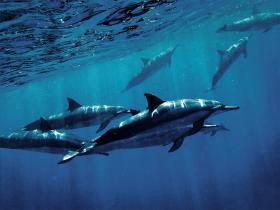 “There has been a high number of dolphin sightings recently. Fish do move around, so the fact that they are close to shore isn’t completely unusual,” Ms Williams said.
“There has been a high number of dolphin sightings recently. Fish do move around, so the fact that they are close to shore isn’t completely unusual,” Ms Williams said.
“It could mean we are seeing the deaths more prominently. When they die further out, only around 10 per cent will wash up on beaches.”
In December, researchers found that dolphins in Florida were putting themselves at increasing risk of injury and death by getting too close to humans.
An analysis showed that whether being fed or scavenging human left-overs, the animals were exposed to serious danger when they ventured near boats and fishing lines.
Ms Williams said pollution was also likely to be playing a significant role in the rise in dolphin discoveries, as well as attacks by the bottle-nosed species against smaller dolphins.
“Full story: Independent

January 6, 2017
Killer whale at center of ‘Blackfish’ dies
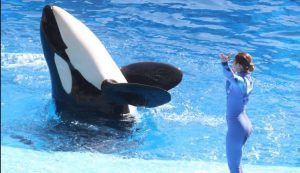 Tilikum, the killer whale involved in the deaths of three people, including SeaWorld trainer Dawn Brancheau in 2010, has died, SeaWorld reported Friday.
Tilikum, the killer whale involved in the deaths of three people, including SeaWorld trainer Dawn Brancheau in 2010, has died, SeaWorld reported Friday.
Tilikum was at the center of the 2013 CNN documentary “Blackfish.”
“Tilikum passed away early this morning, January 6, surrounded by the trainers, care staff and veterinarians that provided him around-the-clock world-class care,” SeaWorld said on its website.
SeaWorld reported in March that the orca — estimated then to be 35 — may be dying. It also announced then that it would no longer house the whales at its water parks.
“Tilikum had, and will continue to have, a special place in the hearts of the SeaWorld family, as well as the millions of people all over the world that he inspired,” SeaWorld president and CEO Joel Manby in a statement. “My heart goes out to our team who cared for him like family.”
The company has come under fire for its treatment of killer whales since the 2013 CNN documentary.
SeaWorld reported in March that the orca — estimated then to be 35 — may be dying. It also announced then that it would no longer house the whales at its water parks.
“Tilikum had, and will continue to have, a special place in the hearts of the SeaWorld family, as well as the millions of people all over the world that he inspired,” SeaWorld president and CEO Joel Manby in a statement. “My heart goes out to our team who cared for him like family.”
The company has come under fire for its treatment of killer whales since the 2013 CNN documentary.
Full story: CNN

November 26, 2016
The dolphins used to treat PTSD in Ukrainian soldiers
Ivan Golubev was a hyperactive child until his school in the Donbass region of eastern Ukraine was attacked by gunfire. The trauma left him unable to to speak.
A few months later he was on holiday in Odessa and his mother, Anna, decided to try dolphin therapy. “By the end of the first session he started talking again, and I just couldn’t stop crying,” she says, as her son splashes round in the pool as part of his follow-up treatment.
The therapy is one of the many dolphin-related attractions in the Black Sea port city, marketed at children with learning difficulties, pregnant women and more recently soldiers injured in the conflict in eastern Ukraine.
Staff at the Nemo centre, who include five psychologists, says there is 1,000-year old evidence that animals can help aid mental and physical rehabilitation, but some clinical experts dispute the benefits while others question whether it is ethical to use wild animals in this way.
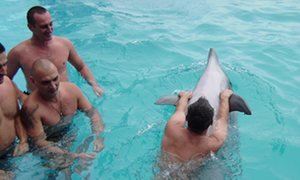
FacebookTwitterPinterest
Soldiers testing the dolphin therapy programme. Photograph: Nemo Centre
As well as resulting in about 10,000 deaths, the war between pro-Russia separatists and the Ukrainian army has left many thousands more with post-traumatic stress disorder (PTSD), a condition not widely recognised in Ukraine.
In September a group of soldiers diagnosed with PTSD came to Odessa to test whether sea mammals could help their rehabilitation.
It’s not a “magic stick” but it can contribute to recovery, claims dolphin trainer and counsellor Yuri Mishkurov, who worked with the servicemen. And while he can’t say how many of the 15 veterans who took part in the programme made a full recovery, he claims that “it’s an effective experience because after the therapy they feel positive emotions”.
“It doesn’t matter whether you are an adult or a child – if you spend time in the pool with this big and friendly animal you will feel better,” adds Bogdan Popovski, who has run the therapy programme for 10 years.
From cats and dogs aiding palliative care to horses helping children with attention deficit disorders, there are animal-assisted therapies on offer around the world. However, some clinical experts argue that there is not enough evidence to show the programmes actually help people with psychological illnesses.
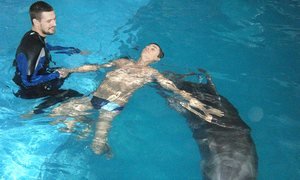
FacebookTwitterPinterest
Dolphin therapy. Photograph: Nemo
Writing in Psychology Today Hal Herzog, who has studied animal and human interaction for 20 years, says claims about dolphin-based therapies remain the most over-hyped of the lot. He concludes that “placebo effects, wishful thinking, and simply having a new experience … are more plausible explanations for the supposed improvements”.
Mishkurov, who has worked at Nemo for four years, says that the most positive impact he had witnessed is on children such as Ivan who start talking again, or become more comfortable socialising. But there has never been any qualitative research on the 1,000 or so children that visit the centre every year.
Ukraine, Russia and Spain are the only European countries to still keep dolphins or whales in captivity, according to animal rights NGO Born Free, which warns that “direct contact between the public and captive cetaceans places both parties at significant risk of disease and injury”.
Full story: The Guardian

September 30, 2016
Humpbacks fight off orcas to save sea lion in maritime battle royale
Some whale watchers are still trying to make sense of an unusual encounter off the southern tip of Vancouver Island that might just rewrite our understanding of interspecies behaviour.
“This was an example of humpback whales coming to the rescue of another marine mammal, in this case a Steller sea lion,” said Michael Harris, the head of the Washington-based Pacific Whale Watch Association.
“We knew there would be some encounters, but we never expected to see something like this. It was an amazing, amazing encounter.”
According to Harris, the incident began when a group of four Bigg’s Killer Whales started hunting a lone Steller sea lion in the waters off Sooke on Sept 11.
“As the hunt was going on, two humpbacks decided to intervene and actually get between the sea lion and the killer whales,” said Harris.
“Then, two more humpbacks joined the fray, literally putting their huge bodies between the orcas and the sea lion, flipping their flukes on the water, trumpeting very, very loud at these transient orcas and ultimately saving this sea lion and escorting it in the other direction of these killer whales.”
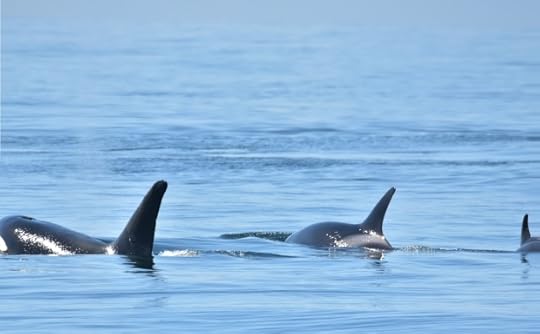
The attack was launched by four Bigg’s killer whales, previously known as transients, whose diet is composed largely of marine mammals. (Alethea Leddy/ Port Angeles Whale Watch)
‘The water boiled all around’
Naturalist Alethea Leddy with the Port Angeles Whale Watch Company was one of the first on the scene and watched the whole encounter unfold.
“The water boiled all around as the orcas tried to separate the sea lion from the humpbacks,” she recalled.
“It was a wild scene with the humpbacks even circling the sea lion trying to keep him safe, while he frantically struggled to get his breath. The anxiety of the humpbacks was palpable, and they took turns diving and slashing at the orcas.
Veteran Capt. Russ Nicks of B.C. Whale Tours of Victoria also saw the attack — and the defence.
“What we witnessed was pure aggression,” Nicks remembereds. “We had four humpbacks trumpeting, rolling on their sides, flukes up in the air multiple times.”
“The killer whales split many times into two groups, with one that appeared to try to draw the humpbacks away from the sea lion. The other group would go in for the attack, while the humpbacks were safely away — but then they’d get in the middle of it again, fighting the orcasoff. It was amazing to watch.”
Eventually, the humpbacks appeared to win the battle with both sides going their separate ways, including the sea lion who stuck with the humpbacks until it was safely out of sight from the hungry killer whales.
“I think the Stellar sea lion was well aware that he had some help out there, and he was lucky he did, because he would have been lunch,” said Harris.
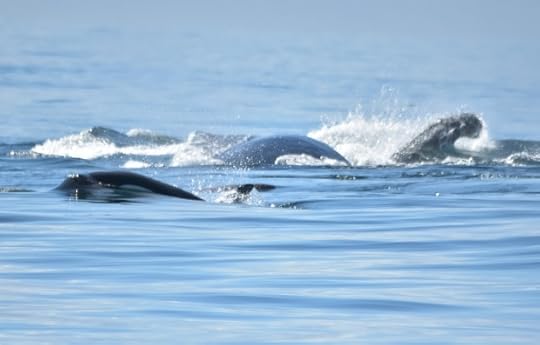
The sea boiled as the three sides battled for position, according to witnesses. ( Alethea Leddy/Port Angeles Whale Watch)
Anthropomorphic interpretation?
Harris says this is the first time he’s heard of this sort of behaviour by whales in the Salish Sea, but it’s actually been reported elsewhere recently.
“A publication came out last month from researchers who were saying they were witnessing humpback whales coming to the rescue of smaller marine mammals and saving them from transient orcas, but we had never seen anything like that in the inland sea.”
According to researchers, most of the time when humpback whales do battle with killer whales, they appear to be acting in an apparently altruistic way to save other marine mammals from the transient predators.
“Nine times out of 10, they are actually intervening to save another species,” said Harris, who admits when he first heard about the research, he was skeptical the researchers were over-interpreting the animals’ behaviour.
“Someone asked me about it, and I said, ‘I’m not so sure about it. I think we would need to see something like that happen. That seems pretty anthropomorphic, like us human beings imparting our own value sets on these creatures out there.'”
“But now we have seen it first-hand, and I am a believer,” he freely admitted.
Full story: British Colombia

September 3, 2016
Dolphin learns to breathe through its mouth after developing a faulty blowhole
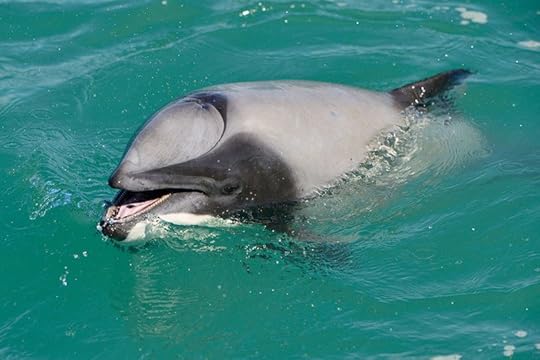
Not just a pretty face? A dolphin has learned to breathe through its mouth after developing a faulty blowhole, highlighting the animal’s ability to adapt.
The adult Hector’s dolphin (Cephalorhynchus hectori) was discovered in January 2014 off the coast of Christchurch in New Zealand.
Steve Dawson at the University of Otago in Dunedin, New Zealand, and his colleagues were studying the endangered species as part of a long-term conservation project, when they noticed unusual behaviour in one member of a group of seven.
Each time the dolphin surfaced, it approached at a steep angle and lifted its head higher out of the water than normal. The blowhole stayed shut while its mouth opened wide and made a sound consistent with sucking in air.
Dolphins were not thought to be able to breathe through their mouths. To do this, a dolphin would need to move its larynx from the usual position to allow the respiratory and digestive tracts to communicate, says Dawson.
The animal probably learned to do this after its blowhole became blocked by a foreign object or injury, or because the muscles around it didn’t work properly, he says. “We think this dolphin has found a workaround to what is most likely a pathological problem.”
Although habitual mouth-breathing has not previously been documented in these animals, some dolphins in captivity have been recorded using their mouths to blow bubbles during play.
Peter Harrison of Southern Cross University in Australia says the finding fits with previous knowledge about the keen intelligence and adaptability of dolphins. “It wouldn’t surprise me that individuals are making discoveries and thinking ‘well that works, so I’m going to learn from that, and see how I can continue to use it’.”
Dawson’s team has now spotted the dolphin more than half a dozen times and found it to be healthy. “It’s in great condition and looks absolutely normal, except for this weird breathing behaviour,” he says. “Clearly it’s a thing that works for the animal.”
Journal reference: Marine Mammal Science, DOI: 10.1111/mms.12349
Source: New Scientist

August 23, 2016
A New Dolphin Species, Long Gone, Found in a Drawer
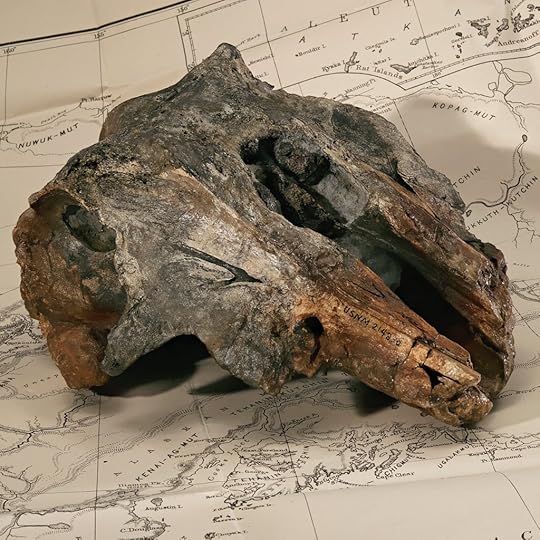 Scientists have determined that a skull that had been sitting in a drawer at the Smithsonian National Museum of Natural History in Washington for more than 60 years belonged to a previously unknown species of extinct dolphin.
Scientists have determined that a skull that had been sitting in a drawer at the Smithsonian National Museum of Natural History in Washington for more than 60 years belonged to a previously unknown species of extinct dolphin.
The animal, whose skull was found in Yakutat, Alaska, in 1951, has been given the name Arktocara yakataga, which can be loosely translated from the Greek as “the north face from Yakutat.” Its description is in the journal PeerJ.
There is one descendant of Arktocara still extant, the South Asian river dolphin, a freshwater animal that is itself on the edge of extinction. Arktocara was almost certainly an oceanic creature.
The dolphin’s discoverer, Alexandra T. Boersma, a researcher at the National Museum, said that judging only from the size of the skull, it was probably about seven and a half feet long. It had a flexible neck, unlike oceanic dolphins, whose necks are hardly distinguishable from their bodies. She estimates that it lived about 25 million years ago.
“One of the great things about the Smithsonian,” Ms. Boersma said, “is that the collections are so vast. We were just walking around to see if anything was interesting. And then, wow!”
Source: New York Times

July 28, 2016
How a grey chunk of rock will rewrite our prehistoric past – an ancient dolphin
No one knew what lay within the grey chunk of rock – or how significant it would prove to be.
For decades it sat forgotten and unloved in a museum warehouse in Melbourne’s outer suburbs. For millennia before that, it languished on a Victorian beach.
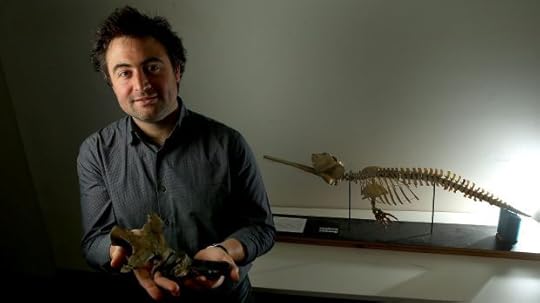
Erich Fitzgerald with one of the dolphin fossils he removed from the Jan Juc rock. Photo: Pat Scala
Then one wintry day in 2003 researcher Erich Fitzgerald spotted it amongst the crates and pallets.
It was the dark chocolate brown lines on the surface of the rock that caught his eye. They provided the first clue. To most of us they’d be unremarkable. But they were enough to draw him in for a closer look. Were they prehistoric bones?
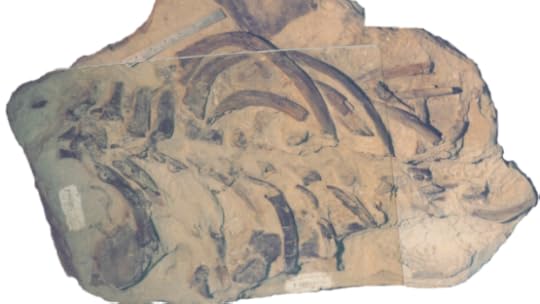
The position of bones in the rock before they were extracted. Photo: Erich Fitzgerald
“I got this surge of adrenaline and thought ‘hey wait a minute, no one else has cottoned on to what is here’,” he said.
The label stated the 100 kilogram lump had been collected by renowned palaeontologist Tom Rich in 1976 from the western end of Jan Juc beach – another hint it could contain something special.
Extracting the fossil from the 25-million-year-old rock was a big job – it took a good 12 months.
What he discovered will rewrite what we know about the prehistoric beasts that lived on our patch.
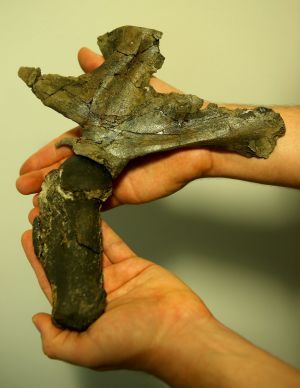
One of the fossils found in the grey rock, decades after it was retrieved from a Victorian beach. Photo: Pat Scala
“This is the equivalent today of discovering that the rhino lived in Australia,” Dr Fitzgerald said. “In terms of the fossil record this represents an entire family that we didn’t even know lived here.”
Chipping away at the rock at a Melbourne Museum laboratory, the layer of broken rib pieces soon made way for a collection flipper bones, organised as they would be in a living animal. This was no rhino.
While the vertebrae were eroded, broken and not particularly informative, the teeth revealed what he was holding.
Here lay the fossilised remains of an extinct dolphin, belonging to a family that had never before been seen in Australian waters. The only other place in the southern hemisphere the dolphin had been found was off the south island of New Zealand, prompting Dr Fitzgerald to nickname it “the Anzac dolphin”.
Source: Sydney Morning Herald




